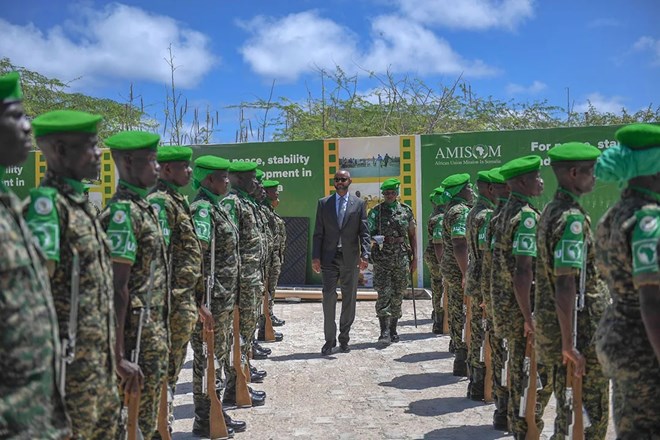
Wednesday May 10, 2023

Abdulkadir Mohamed Nur, Somalia’s minister of defense, inspects Soldiers serving with the African Union Transition Mission in Somalia in Mogadishu on April 1, 2023. ATMIS
After 18 years and three multinational peace missions, Somalia is getting ready to take full control of its own security. The 1-year-old African Union Transitional Mission in Somalia (ATMIS) is preparing to withdraw 2,000 troops from the embattled Horn of Africa nation by June 30, 2023, the first of three drawdowns in its transition plan.
The African Union has committed to withdraw the troops gradually and strategically, sector by sector, with an eye toward ending ATMIS by December 31, 2024. Burundi, Djibouti, Ethiopia, Kenya and Uganda contribute troops to the mission.
Another 3,000 ATMIS troops are expected to leave Somalia by September 30, 2023, and 4,000 more are supposed to depart later. Authorities delayed the initial 2,000-troop withdrawal by six months at the Somali government’s request so that its Soldiers could complete training abroad.
“We want to complete making 15,000 soldiers ready within 2023,” Hussein Sheikh-Ali, national security advisor to Somali President Hassan Sheikh Mohamud, said during a January visit to Washington, D.C.
Somalia sent 3,000 troops each to Eritrea and Uganda. Another 6,000 were to be sent to Ethiopia and Egypt.
Somalia and the countries contributing to ATMIS have a common goal: to turn security over to Somali forces while consolidating and preserving gains made against the al-Shabaab insurgency by ATMIS and the African Union Mission in Somalia (AMISOM), which preceded ATMIS from 2007 to 2022.
Amani Africa, an Addis Ababa, Ethiopia-based policy think tank, noted in an April 28 report that ATMIS continues to face a “dire funding shortfall” as the transition continues. Despite that, ATMIS has made “notable progress” by conducting joint kinetic operations with Somali security forces against al-Shabaab militants since August 2022.
“Such offensives, which benefited greatly from the support provided by local communities, registered significant security gains inflicting defeats on Al Shabaab, particularly in Hirshabelle and Galmudug states, degrading Al Shabaab’s operational capability and recovering several towns and villages from the group,” Amani Africa wrote.
These operational successes led to the handover of the Maslah forward operating base to Somali authorities, the first in a series of base transfers that are part of the four-phase plan to completely shift security responsibilities to Somalia.
That plan would see ATMIS troop levels decrease from the current 18,586 to just more than 9,500 at the end of the transition period in late 2024. Somalia intends to gradually ramp up its force levels to about 23,000 and take over when ATMIS liquidates its assets and fully withdraws.
Throughout the four phases, ATMIS would maintain a police force of 1,040 officers and another several dozen civilian operatives.
With the first withdrawal approaching, presidents of ATMIS troop-contributing countries met April 27 in Entebbe, Uganda, to discuss the mission and the impending drawdown. The officials issued a communique after their meeting calling for “increased logistical support to the Somali Security Forces” and reaffirming United Nations Security Council resolutions seeking a “strategic, gradual, and sector-by-sector approach to the drawdown.” The communique also underscored the importance of force protection such as aviation support. The document also asks that the Security Council lift the arms embargo on Somalia so that the country can adequately meet its security needs.
The council imposed the arms embargo in 1992 in response to conflict and deteriorating humanitarian conditions, according to the Stockholm International Peace Research Institute. The embargo since has been modified several times and remains in force until at least November 17, 2023.
The communique also called upon the AU and its partners to provide funding adequate to sustain ATMIS through the end of its mandate. The European Union is the biggest financial contributor to ATMIS, but it dropped its $154 million funding level in 2022 to about $94 million for 2023, Amani Africa reported. ATMIS saw a total funding shortfall of more than $28 million in 2022. That amount is considerably larger in 2023.
Some observers remain skeptical of the chances for success as the transition progresses. A former al-Shabaab official who defected, Omar Mohamed Abu Ayan, told Voice of America (VOA) that the militant group is withdrawing from territories as Soldiers and militias approach in the hope of trying to convert the battle plan to its advantage.
“They are not defending the towns, which they used to do,” Abu Ayan said. “Instead of moving further away, they are hovering around in the forests nearby the towns, and then they send suicide bombers back into the town.”
Despite all these challenges, Ali said the Somali government will have 24,000 troops ready to go by next year. “There is no reason for ATMIS to stay or to continue to stay in Somalia,” he told VOA. He predicted that the Somali government would defeat al-Shabaab by the summer of 2024.
“Our … primary goal is that in the summer of 2024, before June or July, that there will be no al-Shabaab person occupying territory in Somalia,” he said. “You can note that down.”
ATMIS Mandate
The African Union Transition Mission in Somalia (ATMIS) started on April 1, 2022, and replaced the longstanding African Union Mission in Somalia. The ATMIS mandate seeks to:
• Degrade al-Shabaab and other terrorist groups
• Provide security to population centers and open main supply routes
• Develop the capacity of the Somali Security Forces so they can take over security responsibilities by the end of the transition period, which is December 31, 2024
• Support the Federal Government of Somalia’s peace and reconciliation efforts
• Help develop the capacity of the security, justice and local authority institutions of the Federal Government of Somalia and federal member states.